A Tribute To Love That You’ll Carry Thru Life !
A review of a newly released oldie from the Warner Bros. Archive Collection.
Three Comrades (1938) has much going for it: four pleasant stars, camera man Ray Rennahan, script writer F. Scott Fitzgerald, composer Franz Waxman, producer Joseph L. Mankiewicz and director Frank Borzage, as the trailer boasts, “Hollywood’s No. 1 Director of Love Stories.” Much going for it, indeed, and the film is soft-toned and enjoyable.
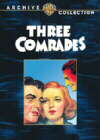 Originally an M-G-M picture, it is nevertheless part of Warner Bros.’ new “Archive Collection,” which also includes RKO as well as Warner Bros. productions. With a starting base of over a hundred films, twenty new titles will be offered each month and discs are made individually, upon order. Many of the films already available in the series are less than masterpieces, such as the middling Western Cattle Town, Clark Gable’s unfortunate Betrayed and the superficial biography of opera star Grace Moore, So This Is Love—all from the 1950s.
Originally an M-G-M picture, it is nevertheless part of Warner Bros.’ new “Archive Collection,” which also includes RKO as well as Warner Bros. productions. With a starting base of over a hundred films, twenty new titles will be offered each month and discs are made individually, upon order. Many of the films already available in the series are less than masterpieces, such as the middling Western Cattle Town, Clark Gable’s unfortunate Betrayed and the superficial biography of opera star Grace Moore, So This Is Love—all from the 1950s.
Among the less than great, which, still, will include long-sought favorites for many fans, there are some treasures: Sunrise at Campobello (1960), the story of Franklin Roosevelt’s early fight against polio; Abe Lincoln in Illinois (1940), with an affecting performance from Henry Fonda, young himself at the time; Mr. Lucky (1943), a delightful Cary Grant comedy aided by a luminous Laraine Day; and even the 1923 silent Scaramouche, with Lewis Stone as the dastardly marquis, the role Mel Ferrer replicated in the 1952 remake, which included a token appearance by Stone.
And, by all means, Three Comrades belongs to this last group, a little jewel of a film.
An extra plus is its literary source—Erich Maria Remarque’s novel, Drei Kameraden, of post-World War I Germany, with its riots, economic depression and cynicism. With an understanding of the time when the film was made, and although there are no specific references to organizations or situations—even the town is unidentified—the parallels with late ’30s Germany and the Nazi menace are obvious. Remarque’s most famous work, literary and cinematically, is All Quiet on the Western Front (1930), although two other well known films include Arch of Triumph (1948) and A Time to Love and a Time to Die (1957).
Author Fitzgerald, a life-long drunkard and drug user who regarded his efforts in Hollywood in the late ’30s as hack work, was notorious for never finishing a script, but that for Three Comrades is reputed to be the only one he completed. Fitzgerald is assisted by Edward E. Paramore, Jr., better known, perhaps, for co-scripting Three Godfathers (1936) and The Oklahoma Kid (1939).
A small footnote: Cedric Gibbons is the art director. His work shows in the authentic feel of the German village sets, often covered in snow, a time of the year appropriate to the somber tone of the film. Gibbons, who worked for Thomas Edison and designed the Oscar statuette, won Academy Awards for a number of films, including The Merry Widow (1934), Gaslight (1944) and An American in Paris (1951).
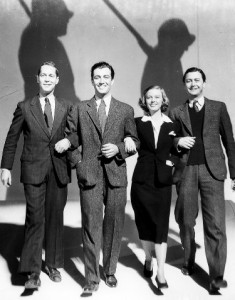 Three Comrades begins at the end of WWI, in a German air force officers’ club, as a man toasts fallen comrades and a brighter future for the country and a father and son embrace, equals now without military protocol. At the bar, toasting themselves, are the three comrades of the title: Erich (Robert Taylor), Otto (Franchot Tone) and Gottfried (Robert Young).
Three Comrades begins at the end of WWI, in a German air force officers’ club, as a man toasts fallen comrades and a brighter future for the country and a father and son embrace, equals now without military protocol. At the bar, toasting themselves, are the three comrades of the title: Erich (Robert Taylor), Otto (Franchot Tone) and Gottfried (Robert Young).
Traveling in a high-speed roadster, the three men race a black sedan driven by Lionel Atwill, in a non-sinister role as Franz Breuer, though he proves to be a blustery, outspoken man. When the roadster stops at an inn, the sedan follows and out steps a young lady (Margaret Sullavan), a “friend,” she says, of Herr Breuer. Fräulein Hollmann has the rather un-German first name of Patricia, or “Pat.” (In fact, no one attempts a German accent in the movie, which also stars Henry Hull, Monty Woolley with customary beard, Charley Grapewin and, speaking of sinister, George Zucco, though here as a caring doctor. Guy Kibbee, as a restaurateur, seems to be sneaking up on a German accent, but nothing is definite.)
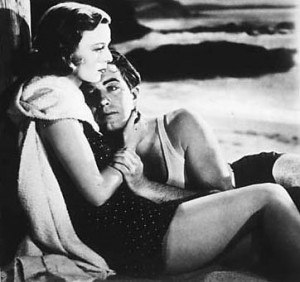 Not to reveal too much of the plot, the story continues with alternations among riots, numerous dining scenes, the men at their auto repair shop, Pat’s interaction with the three friends and her love scenes with Erich. The alert viewer will sense that something is amiss with Pat: a person doesn’t cough in a film, especially in a romantic setting, unless something is wrong. Unscripted, a cough would require a retake! So her scenes, especially with Taylor, have an ethereal, poetic air, reminiscent of similar moments in Wuthering Heights (1939). Even before the coughing is explained, practically from her first appearance, she conveys an underlying melancholy.
Not to reveal too much of the plot, the story continues with alternations among riots, numerous dining scenes, the men at their auto repair shop, Pat’s interaction with the three friends and her love scenes with Erich. The alert viewer will sense that something is amiss with Pat: a person doesn’t cough in a film, especially in a romantic setting, unless something is wrong. Unscripted, a cough would require a retake! So her scenes, especially with Taylor, have an ethereal, poetic air, reminiscent of similar moments in Wuthering Heights (1939). Even before the coughing is explained, practically from her first appearance, she conveys an underlying melancholy.
One of the most poignant moments in the film occurs when Erich bends over the bedridden Pat with his left hand casually beside her temple. “It ticks so loud,” she whispers, “—your watch. It’s so threatening.” Erich tears it from his wrist and throws it across the room. “Now,” she says, “time is standing still.” (Whether Otto’s earlier remark, “There’re no clocks in this café,” is an intentional tie-in with Pat’s is debatable.)
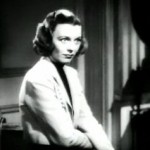 She was nominated for an Oscar for this performance but lost to Bette Davis for Jezebel. Sullavan is ideally suited for this kind of role, for she had, as film scholar Leslie Halliwell so perfectly wrote, “a special whimsical quality which is unique.” Unique it is. There’s a softness about her, at times an almost otherworldliness, even, it might be said, an absence of sensuality.
She was nominated for an Oscar for this performance but lost to Bette Davis for Jezebel. Sullavan is ideally suited for this kind of role, for she had, as film scholar Leslie Halliwell so perfectly wrote, “a special whimsical quality which is unique.” Unique it is. There’s a softness about her, at times an almost otherworldliness, even, it might be said, an absence of sensuality.
That “special whimsical quality” underlies her best films—Shopworn Angel (1938), Mortal Storm (1940) and The Shop Around the Corner (1940), all with James Stewart. The two made a fourth movie together, Next Time We Love (1936), the first film in which, he said, he felt he had done a good job. Sullavan, in fact, was romantically attracted to Stewart and pursued him unsuccessfully.
Unfortunately the actress had a short career—fifteen films between 1933 and 1943, with a late one in 1950, No Sad Songs for Me, in which she plays a mother preparing her family for her death. Sullavan’s life, too, was relatively short, and she died at the age of fifty in 1960.
As for the three male leads, time hasn’t been especially kind to them. The enduring appeal of, say, John Wayne, Cary Grant or Humphrey Bogart eluded them. Of the three, Young perhaps fared the best, abandoning Hollywood around 1955 for TV and two long-running series, Father Knows Best and Marcus Welby, M.D. It’s hard to name a Young film; Alfred Hitchcock’s Secret Agent (1936) comes to mind, more for the novelty of the film itself, or maybe Peter Lorre’s bizarre presence, than for Young’s performance, even though being cast against type as a villain proves quite successful.
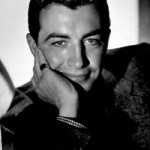 Taylor hit his stride between 1935 and 1940, one of the few actors lucky enough to star opposite Greta Garbo, in Camille (1937). In the early ’50s he made, perhaps, his last noteworthy films, biblical and medieval spectacles—Quo Vadis?, Ivanhoe and Knights of the Round Table. Tone was caught between the proverbial rock and a hard place: he wasn’t handsome enough for a leading man, not charismatic enough for a dramatic actor; he always looks as if the skin has been stretched around his eyes, making them somewhat wild and staring.
Taylor hit his stride between 1935 and 1940, one of the few actors lucky enough to star opposite Greta Garbo, in Camille (1937). In the early ’50s he made, perhaps, his last noteworthy films, biblical and medieval spectacles—Quo Vadis?, Ivanhoe and Knights of the Round Table. Tone was caught between the proverbial rock and a hard place: he wasn’t handsome enough for a leading man, not charismatic enough for a dramatic actor; he always looks as if the skin has been stretched around his eyes, making them somewhat wild and staring.
Three Comrades illustrates the popular cinematic trends and assumptions of the time. Everyone smokes on screen, including Pat (with her lung disease?!), there’re the split screens for telephone calls and Erich plays the piano while engaged in a detailed conversation (do non-pianists know how hard that is to do?).
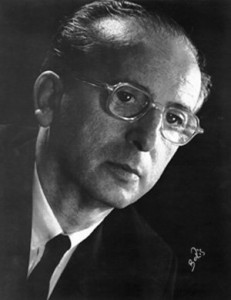 Franz Waxman, who had scored eight or nine films in 1938, is limited in opportunities to express himself, since the main tune/song is apparently by Fridrich Kücken and Emmerich von Hettersdorf, translated as “Give a Man a Man Beside Him.” At one point, the three comrades—now with a fourth, Pat—gather around the piano to sing it, and the tune is heard in the main and end titles at the same march tempo and in the final fade-out in a slower variation. The tune somehow recalls, from ten years earlier, Sigmund Romberg and Oscar Hammerstein II’s marching song, “Stout-Hearted Men,” from their operetta New Moon, filmed in 1940.
Franz Waxman, who had scored eight or nine films in 1938, is limited in opportunities to express himself, since the main tune/song is apparently by Fridrich Kücken and Emmerich von Hettersdorf, translated as “Give a Man a Man Beside Him.” At one point, the three comrades—now with a fourth, Pat—gather around the piano to sing it, and the tune is heard in the main and end titles at the same march tempo and in the final fade-out in a slower variation. The tune somehow recalls, from ten years earlier, Sigmund Romberg and Oscar Hammerstein II’s marching song, “Stout-Hearted Men,” from their operetta New Moon, filmed in 1940.
Waxman, however, has a chance, without dialogue or other soundtrack distractions, to illustrate a favorite screen device—the passage of time, typically, as here, with multiple dissolves of sky, landscapes, especially wind-blown trees and, by all means, the fluttering pages of a calendar. Also, a brief passage for a shot of moon and clouds suggests the opening of his score for Rebecca.
Viewer beware: the film shows no real efforts at restoration. Hiss and crackle are intact. There are no extras, only a trailer which is in bad condition, indeed. Even under these conditions, Three Comrades is a much-deserved release, Sullavan’s acting alone justifies its purchase. A forgotten pearl from Hollywood’s Golden Age. Like many films in the Warner Bros. Archive Collection, it is a real find for those who love the old movies and for those who can obtain a favorite only in this way.
If not in search of a great or even a good movie, which leaves the “other” kind, here’s the opportunity to acquire that clandestine indulgence, that terrible old “B” movie whose identity would prompt a disappointed stare from a friend and a raised eyebrow from an enemy.
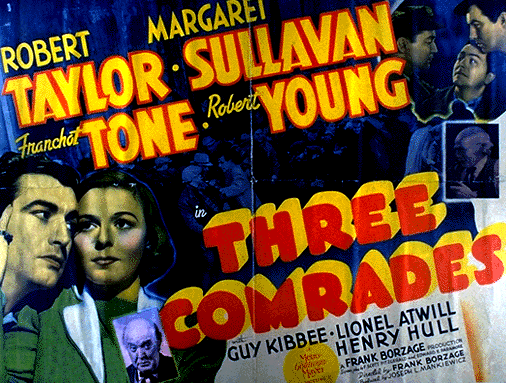
If only! If only! Erich Maria had a voice here! Red Banners striving against Swastikas among the stricken Eagles!